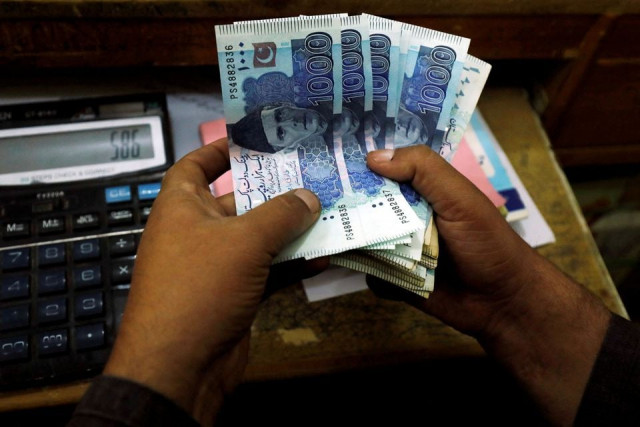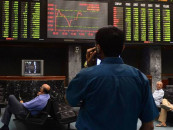PSX top 100 firms reflect 10% growth
Reach net earnings of a cumulative Rs1 trillion

Pakistan Stock Exchange’s (PSX) top 100 listed companies have posted, on an average, 10% growth in net earnings reaching a cumulative Rs1 trillion in the wake of high inflation readings, a high-interest rate regime, massive rupee depreciation and the Russian-Ukraine conflict in 2022.
Some sectors of the economy including banks, oil and gas exploration, marketing companies, refineries, cement manufacturers and chemicals have proven to be beneficiaries of the historical crises. Otherwise, however, the economy has been hit hard – with a large number of factories having completely or partially shut down, millions rendered jobless and a significant portion of households being pushed below the poverty line.
The worsening situation also haunted the Pakistan Stock Exchange (PSX), playing on the minds of share investors, as the benchmark KSE 100 Index –group of the top 100 listed companies – contracted by 9.4% (or 4,176 points) in the year.
Topline Securities said in a commentary that despite the economic challenges, KSE index companies’ net earnings (profit after tax/ PAT) have grown by 10% to Rs1 trillion in 2022 compared to the previous calendar year 2021.
Had the government not imposed super tax on the companies, their net earnings would have been notably higher compared to the average profit earned in the past five years.
The companies have posted a growth of 10% in net profit in 2022 compared to an average of 16% in the last five years (2018-2021).
“The slowdown in growth was primarily due to super tax imposed in 2022 to bridge government revenue shortfall,” said the brokerage house.
“Profit before tax (PBT) of the companies increased by 34% year-on-year in 2022 to Rs1.8 trillion compared to average PBT growth for the last five years (2018-2021) at 16%.”
Arif Habib Limited (AHL) elaborated that the jump in earnings, in the calendar year 2022, was led by the 15.5% growth in the index-heavy commercial bank’s sector to Rs302 billion, “owed to a striking increase in interest rates… the profit before tax (PBT) growth was much more impressive at 42.6% as the bank booked a heavy super tax charge during the year.”
This was followed by another heavy weight: the Oil and Gas Exploration sector. The sector’s profit surged by 33.3% to Rs300 billion, compared to 2021, “given higher oil prices post the Russia-Ukraine conflict and (rupee-dollar) exchange gains booked amid rupee depreciation,” it said.
The cement sector also impressed with a 14.5% jump in earnings to Rs61 billion “in lieu of higher retention prices and use of cheaper coal from Afghan and local markets during the year, which offset the impact of volumetric decline (-16% YoY), hike in energy tariff as well as rupee depreciation.”
The 11.4% jump in earnings of the oil and gas marketing sector to Rs68 billion was supported by “inventory gains.” Whereas profitability of the chemical sector increased by 2.2% year-on-year to Rs38 billion which was “aided by higher PTA margins and rupee depreciation.”
The refinery sector displayed a four-time growth in profitability to Rs25 billion “due to inventory gains and higher GRMs (gross refinery margins),” said AHL.
On the other hand, a sector that remained laggard in the calendar year 2022 includes the fertiliser sector. Its profit dropped by 16.7% YoY to Rs64 billion as DAP sales were impacted (-36% YoY) by high prices, coupled with the imposition of super tax, which axed the bottom-line.
The technology sector also witnessed a 10.8% YoY contraction in profitability to Rs11 billion, particularly given the losses booked by PTC. Earnings of the power sector shrunk by 42.8% YoY to Rs24 billion as K-Electric posted a loss in CY22.
The automobile and steel (engineering) sectors came under pressure as margins were slashed due to LC (letters of credit) issues and high input (scrap and hot-rolled coil/HRC) prices, rupee depreciation and augmented energy tariff, as well as an increase in borrowing costs (interest rate hikes), which eroded the net earnings by 45% and 75% YoY to Rs18 billion and Rs5 billion, respectively, AHL said.
During the year under review, however, the KSE-100 index went down by 9.4% (or by 4,176 points) to 40,420 points on the last working day of the year December 30, 2022. Surprisingly, the banking sector emerged as the worst-performing sector on the index, posting the single largest profit of Rs302 billion in the year, eroding 1,844 points followed by cement (-1,391 points), pharmaceuticals (-494 points), engineering (-301 points), and food (-295 points). Whereas key gainers were fertiliser (619 points), power (312 points), technology and communication (287 points) and chemicals (103 points).
AHL commented that the domestic economic slowdown has been excruciating undoubtedly. History repeated itself as Pakistan’s GDP grew too much, too fast, which put the external sector at risk; imported inflation charged up local CPI, exerting pressure on the currency and necessitating interest rate hikes to curb demand and anchor rising price levels.
While all this came into play, lack of access to external financing and floods further devastated the economy, eroding any previous signs of growth.
Temporary administrative measures such as restrictions set by the central bank on imports also triggered supply-side issues in the country, and as a result, local industries augmented prices unhinged. Meanwhile, the government also imposed a hefty 10% super tax on corporates to bridge some of its financing needs.
Published in The Express Tribune, March 5th, 2023.
Like Business on Facebook, follow @TribuneBiz on Twitter to stay informed and join in the conversation.

















COMMENTS
Comments are moderated and generally will be posted if they are on-topic and not abusive.
For more information, please see our Comments FAQ